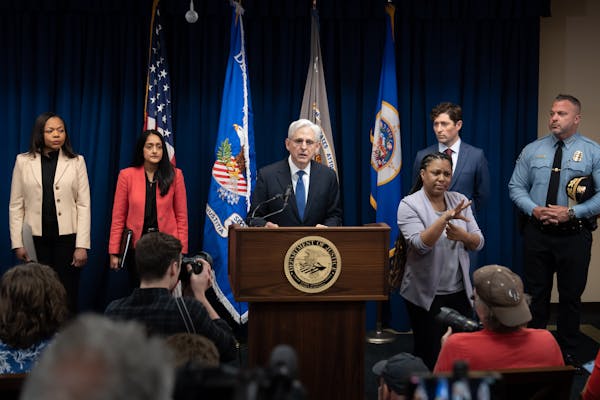What you need to know about the federal investigation of Minneapolis police
The U.S. Department of Justice released an 89-page report Friday that details how Minneapolis police officers used excessive force against residents from 2016 to 2022, violating their constitutional and federal rights, and recommends several corrective measures. Mayor Jacob Frey has already agreed to negotiate a court-enforced improvement plan.
What does that mean and what will happen next?
Overview
What is this federal report?
Two years ago, U.S. Attorney General Merrick Garland announced a "pattern and practice" investigation of the Minneapolis Police Department, the city of Minneapolis and the state of Minnesota. The investigation examined violations of federal law, including the Civil Rights Act, and the use of force against people with disabilities and those engaged in First Amendment protected activities, such as protesting and newsgathering. The Department of Justice report released Friday lays out the long-awaited findings.
What were the findings?
The DOJ found four main categories of federal law violations.
- MPD uses excessive force, causing unnecessary death, striking people who are restrained and failing to give medical aid to people in custody.
- MPD discriminates against Black and Native American people during stops. After the murder of George Floyd in 2020, many officers stopped reporting race, creating gaps in data while failing to address known racial disparities, damaging public trust.
- MPD violates the First Amendment, retaliating against members of the public and journalists who record police actions.
- MPD and the city of Minneapolis violate the Americans with Disabilities Act in their actions toward people with behavioral health disabilities. Officers choke, use Tasers and forcibly arrest people who are having mental crises and behaving erratically but otherwise pose no threat to others.
These violations occurred because MPD's training does not ensure constitutional policing, and its accountability system does not allow for fair misconduct investigations, the report says.
What happens now?
The city of Minneapolis will negotiate an agreement with the DOJ. That eventual agreement will explain how the city will reform the Police Department to stop violating the rights of residents. The agreement must then be approved by a federal court, which will issue an order enforcing compliance, called a consent decree.
Typically, a consent decree will identify an independent monitor — a team of experts who understand large-city policing — to make sure the settlement agreement is carried out and keep the court and public informed along the way.
Where have the federal government and the DOJ used consent decrees before?
The Violent Crime Control and Law Enforcement Act of 1994 allows the DOJ to sue state and local governments whose law enforcement officers exhibit a pattern or practice of depriving individuals of their constitutional rights.
Since 1994, the DOJ has entered into consent decrees with many cities, including Pittsburgh; Los Angeles; Baltimore; New Orleans; Seattle; Portland, Ore.; Albuquerque, N.M.; and Newark, N.J., where Minneapolis Police Chief Brian O'Hara is from. His experience navigating Newark's consent decree played a major role in his hiring last year.
Most consent decrees have been federal. In Chicago, the DOJ under President Barack Obama found federal law violations by the Chicago Police Department following the 2015 killing of Laquan McDonald, but because the DOJ under President Donald Trump declined to negotiate a consent decree with the city, the state attorney general ultimately stepped in.
How long do consent decrees generally last?
There is no specific end date.
A city can ask for a consent decree to be lifted after demonstrating that it has made measurable changes to create a community-oriented police force that acts constitutionally. The court would have to agree.
Pittsburgh's consent decree lasted five years. In Los Angeles, it lasted 13 years.
Previous reports
How is this different from the Minnesota Department of Human Rights report or other reports on policing released since the murder of George Floyd?
The DOJ examined whether the Minneapolis Police Department violated federal law, while the Minnesota Department of Human Rights report looked for violations of state law.
Separately, the city of Minneapolis commissioned the risk management consultant Hillard Heintze to assess the breakdown of its response to the civil unrest in the days immediately following Floyd's murder. That report, released last year, reviewed the crisis management procedures of many city departments and presented specific recommendations to change how MPD deals with crowd control and lawful protests.
Did those earlier reports lead to any changes?
After Floyd's murder, the Minnesota Department of Human Rights charged the Minneapolis Police Department with engaging in race-based policing in violation of the state's Human Rights Act. A subsequent investigation looking at the department's practices over a decade found probable cause of racial discrimination, and the city and state have negotiated a settlement agreement.
The case led to a temporary restraining order that forces MPD to ban chokeholds, limit who can authorize crowd-control weapons and speed up discipline decisions. But the overall settlement agreement between the city and the Minnesota Department of Human Rights has not yet been approved by the court. There will be a hearing next month to determine whether the Police Officers Federation of Minneapolis will be allowed to have a role in that case.
The city has already begun the process of removing police sergeants from the collective bargaining unit of rank-and-file officers, citing the coming state consent decree and the importance of police leaders keeping subordinates accountable. That issue is still playing out before the Bureau of Mediation Services.
Over the last year, MPD has been giving the City Council quarterly updates on the adoption of the recommendations in the Hillard Heintze report. So far, MPD has restricted the use of less-lethal 40mm launchers and clarified in policy that officers must not interfere with lawful protests.
